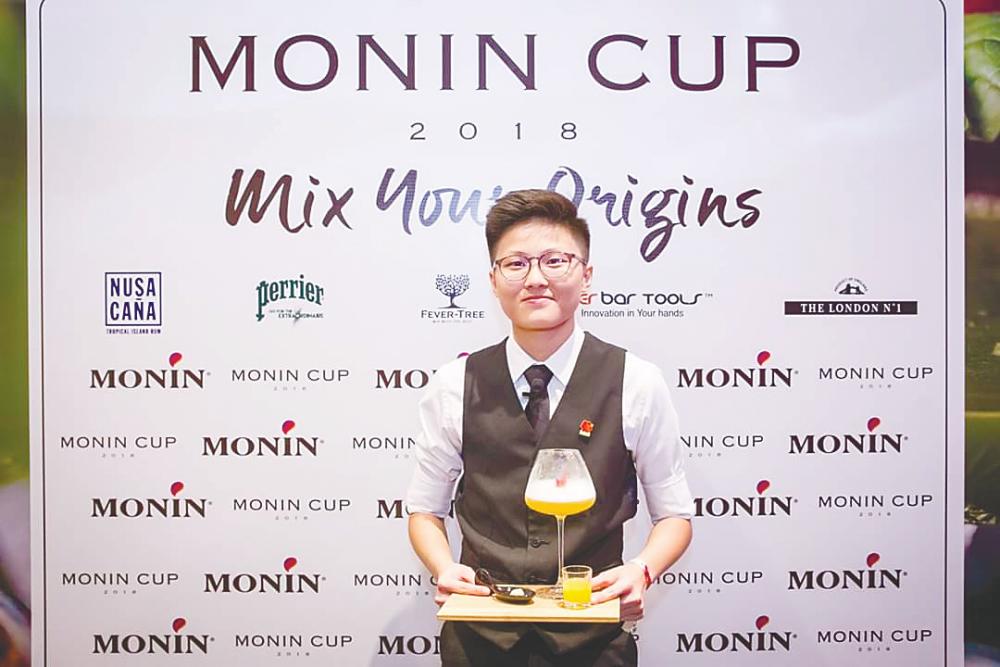PIQUING interest with unusual ingredients that she is familiar with, aspiring bartender Ivon Soon won the judges’ hearts with her cocktail Bayu Kenyalang at last year’s Monin Student Cup.
Soon drew inspiration from her hometown of Sabah, utilising the native tropical fruit bambangan in her winning cocktail, plus, Sarawak’s take on rice wine called tuak, as a nod to the rugged island of Borneo.
While the 20-year-old never imagined she would pick up an interest in cocktails and bartending, it soon developed after diving into the competition.
Hoping to open her own bar someday, the Monin Student Cup was also where she encountered final round judge and Omakase + Appreciate co-founder/bartender Shawn Chong.
Now the Berjaya University student not only moonlights as a waiter at the speakeasy bar building a solid foundation for classic cocktail knowledge but also calls Chong her mentor.
According to Soon, the biggest takeaway from the experience with the professional bartender would be “his hospitality,” which also helped when it came to training for the competition prior.
“The judges did say they were shocked to know I was a student because of my performance. But then I would have to thank Shawn because he trained me very well for that.”
“It’s how to treat guests, like what’s the proper way to treat a guest. I think that’s the main thing.”
What flavours do you like to play with?
If me, I would go for savoury kind of things, like putting salt inside the drink because it’s - not to say unique, but generally people, they don’t really understand.
They only think that the cocktail has to be sweet, sour, things like that. But savoury I think is quite fun actually. The salt can actually enhance all the other ingredients.
If you had to customise a drink, what would you make?
Not so sure about it but I will try to use Assam Boi, because it’s fun. It’s salty, it’s sweet, and the taste is quite strong. It’s quite interesting if you use that to make drinks.
What was something you learned on your first day?
The basics like stirring and Japanese shaking style [with] a three-piece cocktail shaker. There are different shaking styles for different purposes.
Because Shawn is more focused on the Japanese style – means it is more elegant. It is not like the American bartender.
They want to be fast and can be messy. The Japanese way is more focused on elegance and style.
Would you choose trends or classic flavours?
Classic flavours. Because I’m new in this industry, I have to taste all the classics and master all my classics first. The trends now, yeah, it’s nice, it’s flavourful and I think, Instagrammable, but for me, I’m thinking I have to master the basics first.
As my mentor said, every cocktail inspired, must be inspired by a classic cocktail so every cocktail nowadays, is inspired by that.
It’s not that I like the classics, but it’s a basic that I need to learn. So like you see nowadays, a lot of people don’t know classics, that’s why I choose to learn from them [at Omakase].
What is the Bayu Kenyalang based on?
Tom Collins, I could say. Tom Collins is a classic. It’s gin, sugar, and sours.
Because I used bambangan for my base, I didn’t want everything to cover the taste of bambangan. Or neither the bambangan to cover every other taste of my drink.
What inspired the bambangan?
Bambangan is a fruit that is found in Sabah. I’m from Sabah, that’s why that inspired me. One of my lecturers is also Sabahan. He was very supportive of me using this ingredient.
So the bambangan has a very acquired and pungent taste like durian. Not everyone can accept the taste.
The concept of my drink is of Borneo - the Sabah and Sarawak combination. So I also used Tuak - a rice wine from Sarawak.
That’s why I looked for the bambangan taste, and also the tuak, the balance together. For something refreshing, I added the kaffir lime leaves.
Have you customised your own cocktail while working?
No, I haven’t been trained yet because Shawn still asks me to read more books about the classics, so I’m still processing it. It’s challenging because different types of customers want different flavours.
I’m working as a waiter over there but ... he will still like to teach us about cocktail knowledge, drink knowledge, things like that.
For me, I like a challenge. Because you see, at most bars they just stick with the menu, like if guests order this drink, I already got the recipe so ... it’s like doing the same thing [again and again].
There’s no challenge at all. At Omakase, you have to get the basic, the classics, to make any Omakase drink, so it’s quite challenging.










